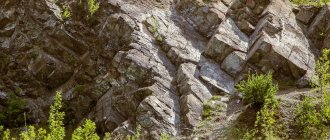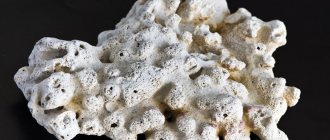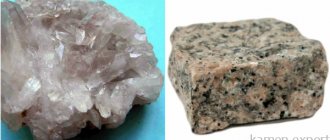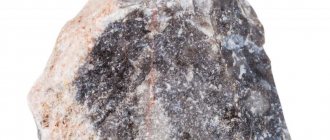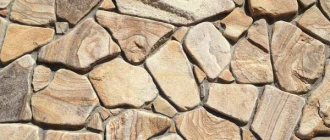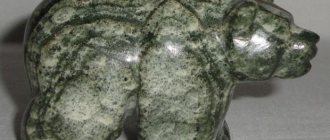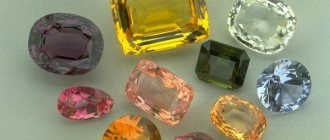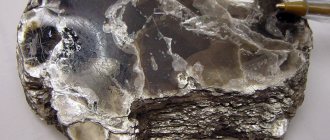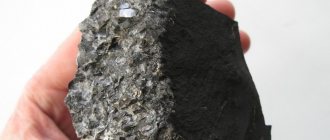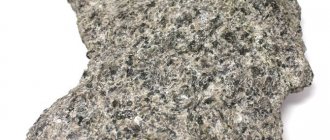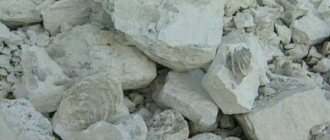Everyone is familiar with limestone: both pliable chalk and durable marble are essentially it. The mineral is unprepossessing in appearance, not rare in nature, and not difficult to process.
And with all this, he managed to become famous in culture and history: ancient Egyptian pyramids, majestic temples and cathedrals, the famous Wall of China, the Moscow Kremlin and other masterpiece buildings were created from it.
There are many signs associated with it; truly miraculous properties are attributed to it. The origin of natural limestone, its varieties, and various uses will be discussed further.
Limestone: origin of the rock
Limestone rock
Natural stone limestone is a non-solid sedimentary rock with a maximum content of calcite. The rest of the mineral mass consists of inclusions of particles of other substances (silicon, phosphates, quartz, lime, etc.).
Microparticles of the skeletons of simple organisms can also be found in the mass of calcium carbonate. The origin is generally characterized as organic, but there is also an organo-chemical path to the formation of the mineral.
The limestone mineral is mainly formed in the shallow water environment of the sea basin. Freshwater conditions also allow limestone to be deposited. Its usual form of occurrence is a layer.
It can be deposited according to the principle of salt: during the evaporation of water from lakes and lagoons. But the bulk of the stone originated precisely in the depths of the sea, where there were no intense processes of evaporation and drying.
The natural mechanism of mineral formation begins with the work of living organisms. They extract calcite from seawater and build shells. Then the remains of their skeletons accumulate on the bottom surface in a huge mass.
The most significant example of the formation of calcite carbonate is the birth, growth and death of coral reefs. It is not uncommon for piece shells to be found on a fracture in a calcareous rock. This variety is called shell rock.
Other species are also named according to the types of organisms and their metabolic products:
- nummulitic limestone;
- bryozoan limestone;
- oolitic limestone.
Marble-like limestone is a separate category. It, in turn, is divided into massively layered and thin-layered types.
Under the influence of certain temperatures and pressure, it changes the structure of the crystals and is transformed into marble.
What are formations characterized by?
Among carbonate deposits, the following types of limestone are distinguished:
- dense carbonates (characterized by a homogeneous structure);
- oolitic formations of spherical shape;
- tuffs are formations with large pores, which are durable and easy to process (polished, grinded);
- travertine – sinter formations;
- clayey and bituminous limestones.
The coral limestone in the sediments is supplemented with an admixture of foraminiferal shells and mollusks, and echinoderm shells. The rock that makes up modern reefs has a hard, porous structure and consists of the skeletons of colonies of polyps.
Putilov limestone is known as the main building material used during the construction of the city of St. Petersburg. The name of the rock is associated with the Putilov deposit located nearby.
The density of limestone is average, it does not collapse under the influence of shock loads, and is resistant to abrasion, aggressive acidic environments and salts. It contains small voids formed as a result of rock leaching.
The color of limestone is gray, alternating with dark gray. The crystalline mineral formation of organogenic origin contains dolomite (2-25%), glauconite grains (up to 20%), phosphates (2-3%), grains of silicate compounds (quartz).
Due to its external similarity, limestone is often mistaken for marble. The difference between breeds lies in the form of their formation. For example, the black Portoro marble from which sculptures are created is a sedimentary rock. The structure of limestone is different from marble.
The formation of marble occurs through the process of metamorphic changes and recrystallization of rock. It contains no traces of fossils.
If the conversion process is not completed, the result is marbled limestone. It is this rock that contains white calcite inclusions of bioherms (corals), shells, and fragments of skeletons of other marine inhabitants.
The petrographic and mineralogical definition of the rock is “marble-like limestone.” In the literature on engineering geology, in the section devoted to the classification of rock types, incompletely transformed limestone is called marble.
Dolomitized limestone is a gray and dark gray sedimentary rock composed of calcite and dolomite. The mineral composition of the formations is formed by inclusions of gypsum, anhydrite and silicon, feldspars, pyrite, clayey matter and flora relics (blue algae).
The strength of limestone, which includes magnesium carbonate (about 40%), during compression is 400-1300 kgf/cm², the hardness of dolomite on the Mohs scale is 3.5-4.5.
Limestone mineral: properties, formula and description
Natural stone limestone photo
As already said, the lion's share of the mineral's composition is calcium carbonate. The chemical formula of limestone is CaCO3. The properties of this compound allow it to dissolve in water. In nature, this process has global significance: in this way, limestone becomes an important participant in the formation of karst forms of underground relief. Under some conditions, CaCO3 also decomposes into a number of bases, where the most voluminous is carbon dioxide. This reaction also plays a global role in natural life - natural carbonation of mineral waters occurs.
The mineral varieties are characterized by color as follows:
- Traditional colors are light gray, white or cream.
- Colors - pinkish, yellowish, reddish, blue and black.
There is no shine as a specific feature. Density: - /+ 2.6 points. Frost resistance and high thermal insulation.
When the rock is fired, quicklime is formed - one of the oldest building materials.
And when it is dissolved in acetic compounds, an aggressive reaction is obtained with hissing, bubbling and complete dissolution of the mineral.
This, by the way, is the surest way to distinguish natural stone from fake.
Varieties
There are many types of limestone. Shell rock is usually called an accumulation of shells and their fragments cemented into a cellular rock. In the case when the shells are very small in size, soft, loosely bound, smearing, finely crumbling limestone is formed - chalk. Oolitic rock consists of miniature, fish egg-sized, cemented balls. The core of each of them can be represented by a fragment of a shell, a grain of sand, or any other particle of foreign material. In the case when the balls are larger in size, for example, the size of a pea, they are usually called pisolites, and the rock, accordingly, is called pisolite limestone. The next variety is travertine - it is formed on the surface during the precipitation of aragonite or calcite from the waters of carbon dioxide sources. If such deposits have a highly porous (spongy) base, it is called tuff. An unconsolidated mixture of clay and calcium carbonate is called marl.
In addition, limestones may differ in color. The main color is white. But it can also be yellowish, light beige, light gray, less often – slightly pinkish. The white-pink and white-yellow breeds are considered the most valuable.
Limestone stone deposits
Some mountain ranges are entirely composed of this mineral. The breed is widespread in the Alps and Crimea.
Of the continents, North America is also rich in stone, but Australia is lagging behind in this sense: its constituent rocks do not contain calcite.
The most fertile deposits are concentrated in the Caucasus, the Siberian region, and the Urals. China is an important supplier of a type of construction mineral – marl.
The Zhdanovskoye deposit, which was developed on the territory of the Russian Federation in the Orenburg region, is recognized as a very promising modern source of limestone.
Interesting Facts
The peoples of South and Central America made a great contribution to the development of stone carving. The Olmecs, Aztecs, and Mayans achieved significant success in the ability to make weapons, cutting tools and other household items from chalcedony, obsidian and silicon. Thus, they created rolling pins, grain grinders, mortars, etc. from basalt, sandstones and limestones. Percussion and chopping tools were made from diorite, jadeite, jade and other materials. The main centers for stone processing are the Mayan cities of Tonina and Nebah.
Applications of limestone stone
Processed limestone stone
Over the entire period of its existence, people have deeply understood the properties of this natural gift and learned to use it with maximum benefit.
Here are the main areas of human activity where limestone is an important material:
- Construction. Varieties of stone are useful here in everything: in the construction of stable high-rise buildings, in cladding facades and for paving surfaces.
- Landscape design and architecture. Ease of processing and decorative properties are highly valued in these areas, especially when it comes to layered types of mineral with a characteristic weathering pattern.
- Production of finishing materials. Here the emphasis is not on decorativeness, but on the organic origin of the stone.
- Cretaceous rocks are used to make crayons, tooth powders, and the production of expensive high-quality paper.
- Cable production cannot proceed without coating welding electrodes with limestone compounds.
- The printing industry widely uses lithographic limestone to create highly artistic engravings.
- Jewelry making. Translucent samples of pastel colors are appreciated. The best design and decorative combinations are obtained with silver and cupronickel frames.
Chemical industry
Even things like shoe polish, toothpaste, cleaning powder, etc., which we use every day, are derived from limestone. These raw materials are also used in the manufacture of products used to protect the environment from various types of pollution. Based on all of the above, we can safely say that the widely known and accessible material, which is limestone, represents the most important element of modern civilization.
Limestone stone: beneficial properties
Lithotherapists, basing their recommendations on the experience of many generations, advise using the mineral as a remedy with the following qualities:
- absorbent;
- hypoallergenic;
- antiseptic.
For any illness, it is considered beneficial to drink water that has been purified with calcite.
It is also believed that limestone stones purify and disinfect indoor air.
Limestone can only cause harm to those who mine it - inhaling mineral dust and its settling in the lungs does not have the best effect on health.
There is a whole gradation of the healing properties of limestone based on color:
- Reddish calcite. Treats nervous feelings and blood diseases.
- Yellowish limestone. For meditation and regulation of digestion.
- Pink varieties. Nervous disorders, healthy sleep.
- Blue limestone. Reduced pressure.
The therapeutic effect is achieved through contact with the stone: it is applied to the diseased area.
You can simply hold it in your hands during individual attacks and manifestations of the disease.
Impact of climatic conditions
Depending on the level of humidity, the properties of limestone may change. First of all, this affects its strength - it decreases noticeably if the stone is wet. In addition, most deposits are characterized by rock heterogeneity. It is worth paying special attention to this point, since a heterogeneous material will have different densities, which, in turn, can lead to destruction. When analyzing the properties of limestone, one should not neglect such a parameter as frost resistance: this significantly affects the strength of the mineral and the duration of its use. Thus, crystalline limestones have frost resistance of 300-400 cycles. However, this indicator is noticeably reduced in the presence of cracks and pores in the material. Thus, all the mentioned properties of limestone must be taken into account when using this natural material in order to prevent its destruction.
Limestone stone: magical properties and zodiac signs
In magic, a legend is associated with the stone that it develops the extrasensory abilities of every person and opens the way to clairvoyance.
This is a talisman against laziness and for creative imagination. Astrologers have included limestone in the list of universal stones suitable for most zodiac signs.
Only Scorpios are excluded - among them there are most people prone to the occult and black magic. And limestone, in its aura, is a conductor of light energy and high spiritual vibrations. This contradicts the mystical bias of Scorpios, and the limestone talisman is “not friendly” with the strong-willed and aggressive sign.
As for the rest, the mineral willingly shares its invigorating and inspiring properties and helps the owner see the outcome of the situation.
Production
The crushed stone production process consists of extracting the base material rock (granite, limestone, etc.) by explosive means from a mountain range and then processing it.
Primary crushing of large pieces of rock obtained by explosion can also be carried out using smaller-scale explosions or special mobile machines inside the quarry.
The final crushing of the rock and its dispersion into working fractions (sizes) is carried out on special machines for crushing stone, as well as machines for separating the mechanical mixture into fractions. The latter are called "rumble".
Machine "rumble"
They contain a set of oscillating sieves with meshes of certain sizes, thanks to which the mixture is separated into fractions. Each fraction is characterized by minimum and maximum values that define the range of sizes of grains included in this fraction.
For example:
- fraction 5 – 10 mm;
Fraction 5 10 mm
- fraction 10 – 20 mm;
Fraction 10 20 mm
- fraction 5 – 20 mm.
Fraction 5 20 mm
Examples of standard fractions of fine crushed stone are listed here.
A non-standard fraction of 120 – 150 mm is an example of crushed stone with the maximum permissible grain (stone) size.
For more information about the production of limestone crushed stone, watch the video:
conclusions
The performance characteristics and areas of use of crushed limestone are considered. A comparison of the characteristics of limestone and granite crushed stones is presented. It has been shown that while crushed limestone has some disadvantages compared to granite (in terms of strength, frost resistance), there are also advantages (in terms of environmental friendliness).
Taking into account the lower cost of crushed limestone and the wide range of areas for its use, we come to the conclusion that this material is promising in construction and industry.
Characteristics
Bulk density
For a more visual understanding of limestone crushed stone, its characteristics are compared with the corresponding characteristics of granite crushed stone. For limestone crushed stone, the characteristics are given for crystalline rock, which has maximum density (20-40) and strength.
The characteristics of different highly porous limestones vary greatly and are not discussed here. The most important characteristic of crushed stone is its bulk density.
Before considering this parameter, we present the density of the base material (monolith):
- limestone density – 2600 kg/m3;
- granite density – 2600 kg/m3.
Base Density
Despite the identical densities of the base materials, their compaction coefficient in a granular medium is somewhat different:
- bulk density of crushed limestone – 1200 – 1300 kg/m3;
- bulk density of granite crushed stone according to GOST No. 8267-93 – 1300 – 1400 kg/m3.
The following data is available for individual factions:
- bulk density of crushed granite stone of fraction 5 – 20 mm – 1350 kg/m3;
- bulk density of crushed granite stone of fraction 5 – 10 mm – 1380 kg/m3;
- bulk density of limestone crushed stone of fraction 5 – 20 mm – 1250 kg/m3;
- bulk density of limestone crushed stone fraction 10 – 20 mm – 1250 kg/m3.
Strength
This is the main indicator that determines the quality and specifies the area of use of crushed stone. When certifying a material, the strength is determined using specialized installations.
The strength of crushed stone is characterized by parameters called strength grades, which in order of increasing strength vary from M200 to M1400.
The range from M200 to M800 is typical for limestone, from M200 to M1400 – for granite crushed stone. Based on the given values, crushed limestone is somewhat inferior to crushed granite in terms of the considered parameter.
Frost resistance
This parameter characterizes the number of heating and cooling cycles within the maximum range of seasonal temperature changes before the degradation of the material properties begins. The interval for possible parameter changes is from F15 (withstands 15 cycles) to F400 (withstands 400 cycles).
Sand is the most important building material, because without it it is impossible to build a single building or structure. It's all about the bulk density of sand.
It is impossible to imagine finishing work today without tile adhesive. Here is its composition.
Currently, the use of decorative plaster in finishing has become very common among the population. By clicking on the link, you will become familiar with its application.
The climate of our country (except for its southern regions) allows the use of crushed stone with frost resistance F300 and higher. The frost resistance value of crushed stone is determined by its moisture content. Some types of granite materials have frost resistance F300, and limestone materials F150.
Radioactivity
This parameter illustrates the environmental purity of crushed stone. In order of increasing radiation hazard, given by specific radioactivity (Bq/kg), the following categories of crushed stones are recognized:
- low active (less than 370 Bq/kg);
- medium activity (370 – 740 Bq/kg);
- highly active (740 – 1350 Bq/kg).
Of all existing types of crushed stone, limestone is the most environmentally friendly (radioactivity less than 137 Bq/kg).
Flakiness
Flakiness is expressed numerically by the proportion of granules of non-standard (not cuboid) shape. These can be needle-shaped or flattened granules, for which the size in one of the dimensions (for example, length) is more than three times the size in the other two dimensions (width and height).
Flakiness
Granules of this type impair the compactness (density) of crushed stone, which causes increased consumption of the binder cement mortar.
